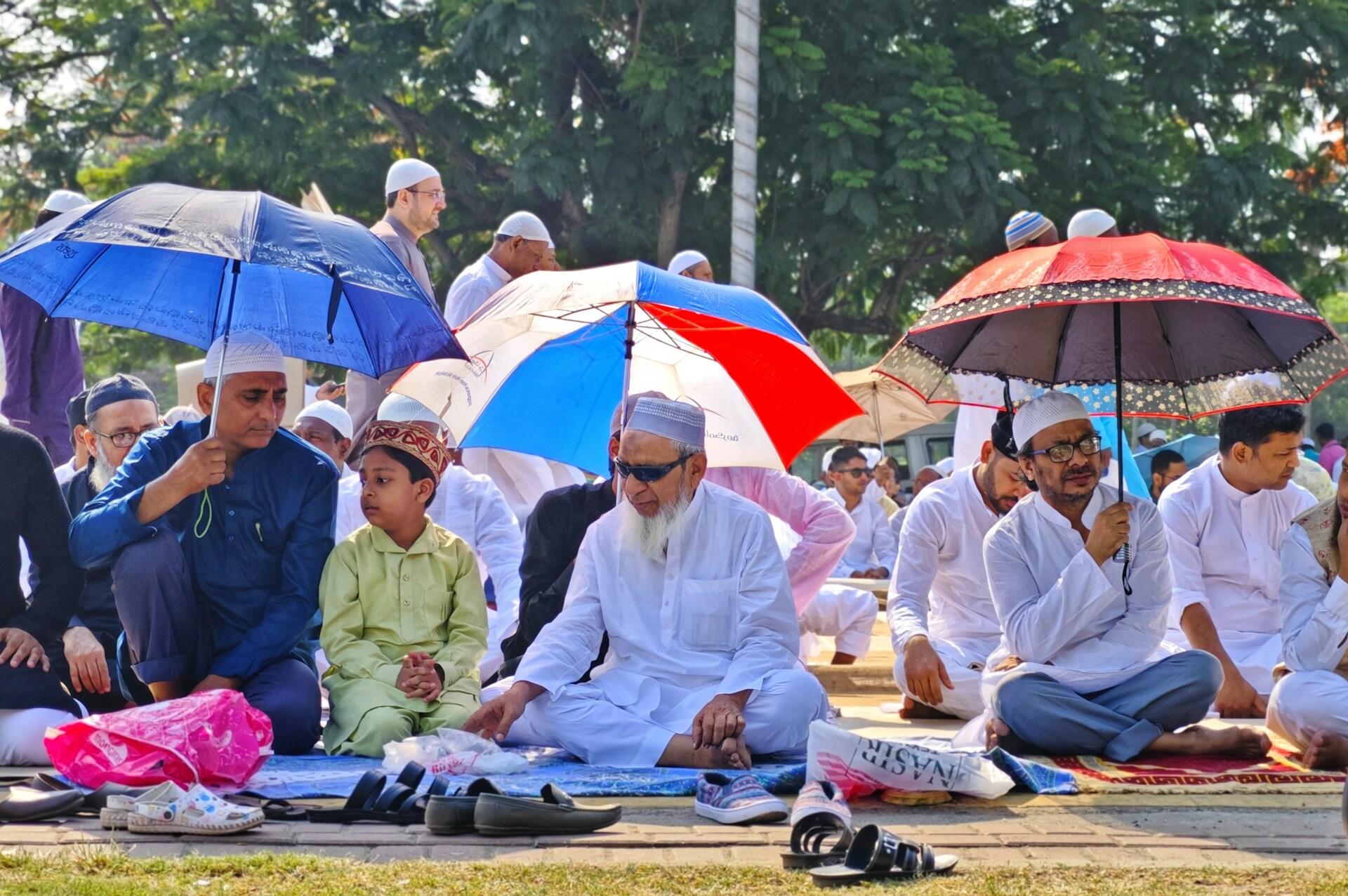Did you know that the Islamic New Year falls on a different date each year according to the Gregorian calendar? That's because it follows the Islamic calendar (known as Hijri), which is a lunar-based calendar with 12 months — where each month begins with the sighting of the new moon. Within these months, there are four designated sacred months due to their religious and historical significance. The four holy months in Islam are:
- Dhul-Qi’dah: A peaceful month before the pilgrimage season. Roughly falls around: May–June
- Dhul-Hijjah: The month when the Hajj pilgrimage and Eid al-Adha take place. Roughly falls around: June–July
- Muharram: The Islamic New Year month, one of the sacred months. Roughly falls around: July–August
- Rajab: A sacred month known for quiet reflection and worship. Roughly falls around: January–February
In this article, we'll dive deeper into the timeline of these four months and discuss its significance among the Muslim community.

The Islamic Lunar Calendar and Its Structure
First, let's review the Islamic lunar calendar's composition and briefly explore the twelve months. It was established as a result of Prophet Muhammad's migration (Hijrah) from Mecca to Medina in 622 CE.
Unlike the Gregorian solar calendar, the Islamic lunar calendar is approximately 10–12 days shorter, which means its dates shift through the seasons rather than remaining fixed. Consequently, each Islamic month consists of 29 or 30 days, resulting in a year of 354 or 355 days.
For the moon to complete one cycle, it takes about 29.53 days. But the concept of half day is not applicable in the calendar; that's why the actual start of a month depends on the sighting of the new crescent moon (hilal). If the crescent is not seen after 29 days, the month completes 30 days.
In terms of months, the beginning of every month is based on every lunar cycle when the crescent moon is visible. This explains why moon sighting is still practised today, especially when determining the exact dates of important observances such as Ramadan.
Here is an overview of the Islamic calendar months with their brief descriptions:
| Month | Arabic Name | Meaning | Brief Description | Approximate Gregorian Range |
|---|---|---|---|---|
| Muharram | ٱلْمُحَرَّم | Forbidden | A sacred month when battles are forbidden. Includes Ashura, the tenth day of significance. | July- August |
| Safar | صَفَر | Void | Named because pre-Islamic houses were empty while occupants gathered food. | August-September |
| Rabi' al-Awwal | رَبِيع ٱلْأَوَّل | The First Spring | Also means to graze; cattle were grazed. Celebrated as the birth month of Prophet Muhammad. | September-October |
| Rabi' ath-Thani | رَبِيع ٱلثَّانِي | The Second or Last Spring | The second spring month following Rabi' al-Awwal. | October-November |
| Jumada al-Awwal | جُمَادَىٰ ٱلْأُولَىٰ | The First of Parched Land | Considered pre-Islamic summer; may relate to freezing temperatures. | November-December |
| Jumada ath-Thani | جُمَادَىٰ ٱلثَّانِيَة | The Second of Parched Land | The last of the parched land months. | December-January |
| Rajab | رَجَب | Respect, Honour | A sacred month prohibiting fighting; name possibly means "to remove," reflecting disarmament traditions. | January-February |
| Sha'ban | شَعْبَان | Scattered | Time when tribes dispersed to find water; lies between Rajab and Ramadan. | February-March |
| Ramadan | رَمَضَان | Burning Heat | The most revered month, where Muslims observe with fasting and heightened devotion. | March-April |
| Shawwal | شَوَّال | Raised | Marking the end of Ramadan with Eid al-Fitr; named for female camels raising their tails. | April-May |
| Dhu al-Qa'dah | ذُو ٱلْقَعْدَة | The One of Truce/Sitting | A holy month banning war; defensive fighting allowed. | May-June |
| Dhu al-Hijjah | ذُو ٱلْحِجَّة | The One of Pilgrimage | Month of the Hajj pilgrimage and Eid al-Adha, a sacred month banning war. | June-July |
*Islamic months shift each year because the lunar calendar is shorter, so the Gregorian months are only approximate.
The Four Sacred Months in Islam
Now, let's review the timeline of the four sacred months, as well as the major events that surround them.

Identification of the Sacred Months
The four sacred months are fixed and observed in the same months each year according to the Islamic calendar.
📌Muharram
- Signifies the beginning of the Islamic new year, as it is the first month of the calendar
- An important Muslim festival, the Ashura falls on the 10th day of Muharram
- During this day, Muslims fast and remember how Prophet Musa delivered the people from Egypt (Sunni), and the Battle of Karbala (Shia).
Muharram, which means forbidden, is the only month among the four sacred months to be attributed to the name of Allah in the Hadith (Sahih Muslim 1163).
📌Rajab
- The seventh month of the Islamic calendar
- A significant celebration during this month is Isra' and Mi'raj, which details two events: The journey of Prophet Muhammad from Makkah to Jerusalem, and the Prophet's ascension to heaven
It is the only sacred month that is not consecutive, unlike the other three months.
📌Dhu al-Qa-dah
- The eleventh month of the Islamic calendar
- A major event that happened during this month was the Treaty of Hudaybiyyah, which allowed peace between Medina and Mecca for 10 years
The Treaty of Hudaybiyyah enabled Muhammad's followers to have their first pilgrimage on the 4th day of Dhu al-Qa-dah.
📌Dhu al-Hijjah
- The final and twelfth month of the Islamic calendar
- An important celebration during this month is Eid al-Adha, which commemorates Prophet Ibrahim's obedience to sacrifice his son, Ismail
This is when the Hajj pilgrimage takes place, where Muslims from around the world gather in Mecca to visit the Kaaba.
Historical Context and Pre-Islamic Significance
Now, let's review the roles of these sacred months in pre-Islamic Arabian society and their transition into Islamic teachings today. During pre-Islamic Arabia, these four months were also considered sacred, but mostly for economic or tribal reasons, instead of spiritual.
That’s because even before Islam, the Arabs practised pilgrimage based on ancient religious traditions to the Kaaba. This brought in thousands of travellers and created various economic opportunities, especially for merchants.
When a month was considered sacred, it meant that no one, regardless of tribe, was allowed to engage in warfare or any form of violence.
This ensured a peaceful and safe journey for both travellers and merchants, fostering a pleasant religious atmosphere and a stable commercial environment.

When Islam came into the picture, the sacred months took on a different meaning. The Qur’an reaffirms the special status of these four holy months, retaining some of their earlier characteristics while removing certain pre-Islamic practices:
Quranic and Hadith References
Let's review some Quranic and Hadith references that back up the religious significance of these four sacred months, as observed among today's Muslim community.
In the Quran, it confirms that there are four sacred months which is divinely ordained.1
Indeed, the number of months ordained by Allah is twelve—in Allah’s Record since the day He created the heavens and the earth—of which four are sacred. That is the Right Way. So do not wrong one another during these months. And fight the polytheists together as they fight together against you. And know that Allah is with those mindful ˹of Him˺
Qur’an 9:36
In terms of Hadith reference 2, the Prophet Muhammad specifically identified the four sacred months by name and order in the Islamic calendar:
The Prophet (ﷺ) said, "Time has come back to its original state which it had when Allah created the Heavens and the Earth; the year is twelve months, four of which are sacred. Three of them are in succession; Dhul-Qa'da, Dhul-Hijja and Al-Muharram, and (the fourth being) Rajab Mudar (named after the tribe of Mudar as they used to respect this month) which stands between Jumad (ath-thani) and Sha'ban."
Bukhari 4662, Muslim 1679

Significance and Observances During the Sacred Months
During the sacred months, it is not just about strictly following the dos and don'ts, but about having the right heart and attitude to be in alignment with the Islamic teachings.
Prohibitions and Ethical Conduct
As mentioned earlier, warfare and violence are prohibited during the four sacred months — Muharram, Rajab, Dhu al-Qi’dah, and Dhu al-Hijjah. The only exception is self-defence.
In today’s context, believers are encouraged to practice patience and to guard their thoughts, speech, and actions to foster peace and harmony with others and with God.
Believers are encouraged to view peace as more than just an external environment, but an internal spiritual practice that produces good behaviours such as honesty, kindness, honesty, and reconciliation through the act of forgiveness too.

Recommended Acts of Worship
Throughout the sacred months, believers are also recommended to increase their acts of worship through various practices as a devotion to God, which will be magnified in value and rewards. 3
Here are some common practices:
Fasting and prayers
- Most believers fast during Ashura (Sunni Muslim)
- Perform daily special remembrance prayers like the dhikr
Reading the Quran
- Side-by-side translation to understand the chapters accurately
- Reflect deeply on the teachings and apply them aptly
Doing charity
- Monetary support through voluntary charity (Sadaqah) to specific organisations
- Acts of kindness (non-monetary form), like spending time with the elderly, teaching skills for free
The Broader Significance of the Sacred Months
The purpose of observing the sacred months among modern-day Muslims has a broader meaning, both in one's personal faith and also communal relationship with other fellow believers.
Spiritual Reflection and Renewal
Every year, the sacred months serve as a reminder for spiritual reflection and spiritual growth. It allows believers to evaluate their thoughts and deeds, and search their hearts if there are any hidden sins that they need to ask for forgiveness, whether it's from man or from God.
These months help them to realign and even set personal spiritual goals for a new month or a new year, as two of the sacred months are on the 12th (Dhu al-Hijjah) and 1st month (Muharram) of the Islamic calendar.
Community and Social Implications
Muslims never have to observe the sacred months alone, as the Muslim community believes in the power of solidarity, especially when participating in communal activities together. Whether it's charity, fasting, or celebrating Islamic major festivals, this practice and togetherness help to foster unity and cultivate a strong bond among the Muslim community.

Timeline Of The Four Sacred Months In the Islamic Calendar
Let's recap the timeline of the four sacred months in the Islamic calendar. 4
Muharram
The first month of the Islamic calendar, where believers celebrate Ashura on the 10th day
The month holds increased rewards and answered prayers.
Rajab
The seventh month of the Islamic calendar, where believers commemorate the Isra and Mi’raj, which the Prophet Muhammad experienced a miraculous night journey and ascended to heaven
Believers are encouraged to increase acts of worship
Dhu al-Qi’dah
The eleventh month of the Islamic calendar and a time when believers start preparing for the Hajj pilgrimage season
Believers are encouraged to spend time in prayer
Dhu al-Hijjah
Twelfth and final month of the Islamic calendar, the first 10 days are the peak of the Hajj pilgrimage, celebration of Eid al-Adha
Believers are encouraged to perform acts of charity
We hope this article has given you some engaging insights on how to identify all four sacred months in the Islamic calendar and understand the encouraged practices throughout these periods. Regardless of whether you are a Muslim, it serves as a great cultural knowledge which could even inspire you to pick up the language behind this belief, which is Arabic.
At Superprof, you can connect with an experienced Arabic tutor to start learning this language regardless of your learning level. As a beginner, you can enjoy personalised one-to-one tutoring in the comfort of your own home. Just head to the Superprof homepage to start browsing the tutors' profiles and review their essential information. After reviewing, just message the desired tutor via the messaging feature. Learning Arabic has never been so easy!
References
- Surah At-Tawbah - 36 - Quran.com. (n.d.). Quran.com. https://quran.com/at-tawbah/36
- Sahih al-Bukhari 4662 - Prophetic Commentary on the Qur’an (Tafseer of the Prophet (pbuh)) - كتاب التفسير - Sunnah.com - Sayings and Teachings of Prophet Muhammad (صلى الله عليه و سلم). (n.d.). https://sunnah.com/bukhari:4662
- S&Amp;M. (2025, February 3). What are the 4 Sacred Months in Islam? Noor Academy : Online Quran, Arabic, and Islamic Studies Classes. https://nooracademy.com/4-sacred-months-in-islam/
- Muslim Welfare Canada. (2024, June 3). The 4 Sacred Months in Islam - MWC. MWC. https://mwcanada.org/press-release/the-4-sacred-months-in-islam/















